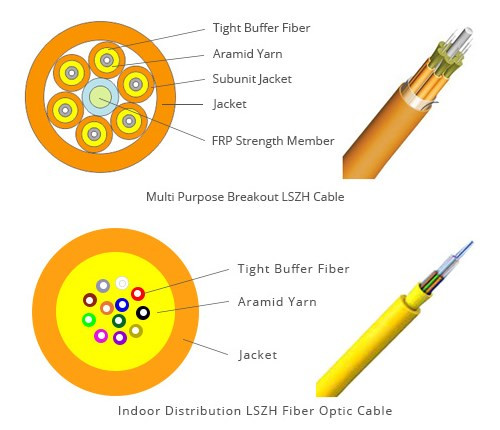June 20, 2016
When choosing fiber optic jumper cables, other than selecting the right connector type on both ends of the cable, such as SC to LC fiber cable, ST ST fiber patch cable, SC/APC to LC patch cable, SC to ST fiber cable, LC to ST fiber patch cable, or SC to SC patch cord, you also need to pay much attention to the construction of fiber optic cables. Nowadays, with increasing amount of cables found in residential, commercial and industrial applications, there is a greater fuel load in the event of a fire. Wire and cable manufacturers responded by developing materials that had a high resistance to fire while maintaining performance. Low-smoke, zero-halogen (LSZH) cables proved to be a key materials group that delivered enhanced fire protection performance. How much do you know about LSZH cables? This post aims at helping you learn more about LSZH fiber optic cables.
LSZH stands for low-smoke zero-halogen, and describes a cable jacket material that is non-halogenated and flame retardant. This type of jacket material has excellent fire safety characteristics of low smoke, low toxicity and low corrosion. When LSZH fiber optic cables (as shown below) come in contact with a flame, very little smoke is produced, making them ideal for applications where a lot of people are confined in a certain place, such as office buildings, train stations, airports, etc. A fire may be very harmful in a building, and at the same time, the smoke can cause even more damage to people who are trying to locate exits and inhalation of smoke or gases. LSZH fiber optic cables are free of halogenated materials like Fluorine (F), Chlorine (Cl), Bromine (Br), Iodine (I) or Astatine (At), and those materials are reported to be capable of being transformed into toxic and corrosive matter during combustion. Low-smoke property of LSZH fiber optic cables makes them safe and helpful. More people in fires die from smoke inhalation. LSZH fiber optic cables release low smoke and zero halogenated materials in these places would be really important to the safty of people.

There is no doubt that the amount of fiber optic cables installed in buildings has been increasing as data communication proliferates. LSZH fiber optic cables have been common in central office telecommunication facilities, due to the large relative fuel load represented by wire and cable. Several applications of LSZH fiber optic cables are:
- Public spaces like train stations, hospitals, schools, high buidings and commercial centers where the pretection of people and equipment from toxic and corrosive gases is critical.
- Data centers contain large amounts of cables, and are usually enclosed spaces with cooling systems that can potentially disperse combustion byproducts through a large area. Other materials burning may also contribute greater amounts of dangerous gases which will outweigh the effect of the cables. There have been notable fires where cables burning contributed to corrosion, but in some instances, better fire response techniques could have prevented this damage.
- Nuclear industry is another area where LSZH fiber optic cables have been and will be used in the future. Major cable manufacturers have been producing LSZH fiber optic cables for nuclear facilities since the early 1990s. The expected construction of new nuclear plants in the U.S. in coming years will almost certainly involve LSZH fiber optic cables.
No two products are the same and many factors will define the suitability of the final product to its application. Research shows that 27 LSZH compounds have huge variation in physical properties. Even using material which meets the base requirements of one of the many specifications available may not result in the best material for the application. When choosing LSZH fiber optic cables, factors such as the environment and price should be considered. An environmental factor such as the temperature of the installation could reduce the flexibility of the cable. Will the application be in an open area or confined? Will other flammable material be present? Many factors need to be taken into consideration. LSZH fiber optic cables also tend to be higher in cost.
When selecting or designing a fiber optic cable or fiber optic jumper cable for any application, the operating enviroments where the fiber optic cable will be used, whether extreme or not, must be considered along with availability, performance, and price. And when the safety of humans and the enviroment is a consideration, along with high-performance and capability, LSZH fiber optic cables provide a good solution for you.
Posted by: jowang at
04:30 AM
| No Comments
| Add Comment
Post contains 760 words, total size 6 kb.
35 queries taking 0.0187 seconds, 70 records returned.
Powered by Minx 1.1.6c-pink.









